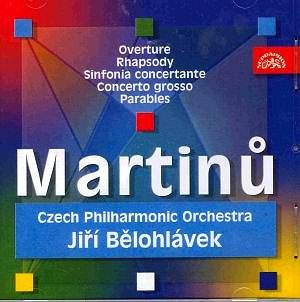Here
are original orchestral works written as early as 1929 and as
late as 1958.
The
otherwise unnamed Overture (what chance does it
stand with that title) was the sole work written by Martinů
in 1953. It has a Handelian weight but this is leavened by the
buoyancy of the Fourth and Fifth Symphonies. Full orchestra are
matched with a concertino of seven solo instruments (flute, violin,
cello, oboe, violin 2, viola, cello 2) in Martinů's favoured
‘Concerto Grosso’ confection - of which more later. It has the
feeling of a sumptuous Bach transcription by Elgar or Stokowski.
‘Rolling,
raw and rollicking’ best describes the wild and woolly Rhapsody
for Large Orchestra. It has something of Ibert, Satie
(definitely not the Gymnopédies) and Honegger about
it. An explosive, active symphonic movement, it was originally
intended for dedication to Koussevitsky. It is closely aligned
with La Bagarre and Half-Time.
Only
three years later came the four movement Sinfonia Concertante
for two orchestras. The touching andante aside,
this is a work that continues the style of the Rhapsody
pretty well without seam or gear-change. The work chatters and
chirps, alive with rhythmic invention and a scattiness I associate
with Prokofiev's Love of Three Oranges. The Concerto
Grosso's middle movement powerfully points a bony finger
towards the doom and foreboding of the Concerto for Double
String Orchestra, Piano and Timpani (still best heard in Sejna’s
now forty year old recording on Supraphon). Otherwise the Concerto
Grosso occupies the same circus ring of spiffing frou-frou
levity as the Sinfonia Concertante.
Parables
is the highlight of this generously timed collection.
Its philosophical track is dictated by Antoine de Saint-Exupéry's
novel Citadelle. The three movements are andante pastorale
(allegories of sculpture), poco moderato (Garden)
and poco allegro (Ship). It is in stylistic touch
with the Sixth Symphony whose buzzing insect clouds are evoked
in the final movement. The first movement takes a Debussian brush
to a theme that seems to have been inspired by the start of Sibelius's
Fifth Symphony.
The
works of the Parisian years (or some of those works) can be a
bit of a trial but the Overture and Rhapsody make
substantial amends. As for the Parables this is a work
that belongs with the symphonies.
Fine
notes and glowingly vivid recording quality from the late 1980s.
Rob
Barnett
